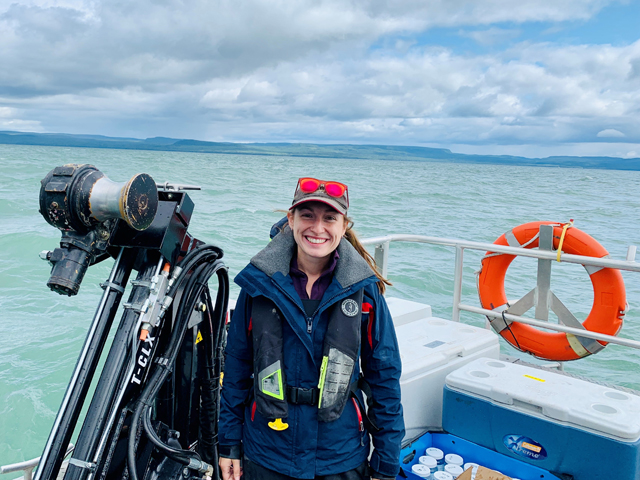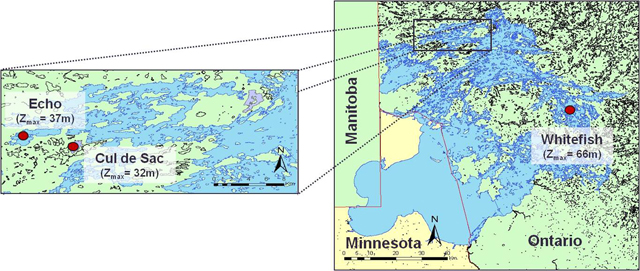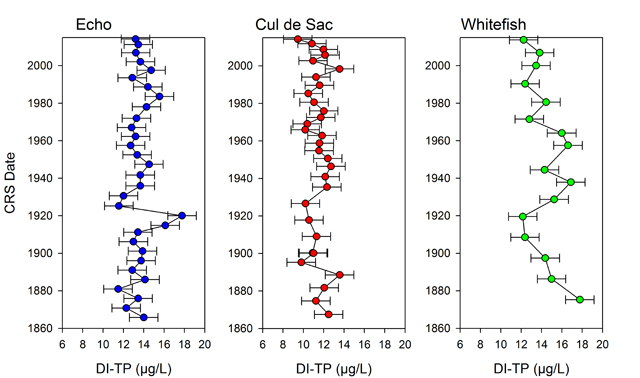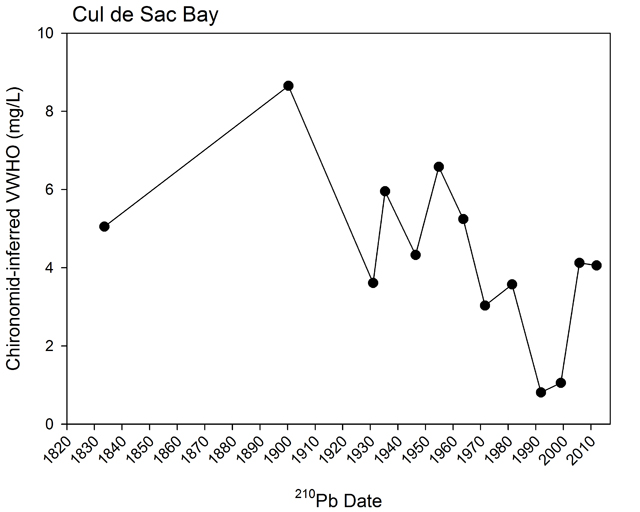By Bev Clark, for the Lake of the Woods Water Sustainability Foundation
 This article summarizes research conducted by Clare Nelligan for her PhD along with her colleagues at the Paleoecological Environmental Assessment and Research Lab (PEARL) of Queen’s University and at the Dorset Environmental Sciences Centre of the Ontario Ministry of Environment, Conservation and Parks. Clare’s research was part of a larger project “Predicting dissolved oxygen concentrations in lake trout lakes: Developing new tools for a multiple-stressor world” at the PEARL (see: queensu.ca/pearl/projects/laketrout/). The Lake of the Woods Water Sustainability Foundation provided financial support to this research project.The first science projects that I worked on in Lake of the Woods involved algal blooms. That was 25 years ago. It was perceived that blooms were getting worse and a solution would be welcomed if possible but, in those days, there was a paucity of data and no clear way to approach
This article summarizes research conducted by Clare Nelligan for her PhD along with her colleagues at the Paleoecological Environmental Assessment and Research Lab (PEARL) of Queen’s University and at the Dorset Environmental Sciences Centre of the Ontario Ministry of Environment, Conservation and Parks. Clare’s research was part of a larger project “Predicting dissolved oxygen concentrations in lake trout lakes: Developing new tools for a multiple-stressor world” at the PEARL (see: queensu.ca/pearl/projects/laketrout/). The Lake of the Woods Water Sustainability Foundation provided financial support to this research project.The first science projects that I worked on in Lake of the Woods involved algal blooms. That was 25 years ago. It was perceived that blooms were getting worse and a solution would be welcomed if possible but, in those days, there was a paucity of data and no clear way to approach
managing the system to produce a positive effect on the blooms. After I inherited the Lake Partner Program around the turn of the century, I began to realize that there was a great deal of grass roots interest in science when it comes to Lake of the Woods. Science coordination in the basin quickly picked up speed and we soon saw the organization of an International Science Forum in International Falls.
In the early days I knew that there were concerns about Lake Trout sustainability in areas of Lake of the Woods, especially in Clearwater Bay. This was after getting over the shock of using the words Lake Trout and Lake of the Woods in the same sentence. OK so now back to that science forum that I mentioned earlier. The great thing about a science forum is that it can coordinate the science community in a way that will provide a focus on the compelling issues. This happened like an avalanche in the Rainy - Lake of the Woods basin. The forum is in its 17th year and has been, by far, the best and most effective cooperation between science partners that I have seen in my career. If you give them a compelling question, and a way to cooperate, the science folks will come over to have a look.
OK, so what about these Lake Trout?
Lake Trout are a sensitive indicator and they need access to ample supplies of cold, oxygenated water during the summer months when they are imprisoned in the bottom waters of the lake (the hypolimnion). Nutrients play a role here because higher nutrients work to reduce oxygen concentrations in areas of the lake near the bottom. In severe cases, the bottom water becomes unusable due to low oxygen so the Lake Trout can’t go down and they can’t go up because they can’t tolerate the warm mixed surface water. They are in a bit of a squeeze. Now its easy to go out and measure current conditions to assess the volume of optimal habitat for the Lake Trout to determine whether or not they are in peril but what we really want to know is - are the conditions getting better or worse from a historical perspective? This is difficult to determine because we don’t have data from years ago. Or do we?
 Sediment cores waiting to be sectionedLuckily there is an investigative technique called paleolimnology that allows us to examine the sections of a core sample from the bottom of the lake to infer the past conditions stretching well back into preindustrial times. Clare Nelligan and her co-workers began such a project in 2017 to examine changes over time in the nutrients and oxygen climate for three different areas of Lake of the Woods that support Lake Trout populations. She used these paleolimnological techniques whereby a sediment core from the bottom of the lake can be sectioned into slices that represent past years. These slices can be examined to infer historical water quality conditions in the lake.
Sediment cores waiting to be sectionedLuckily there is an investigative technique called paleolimnology that allows us to examine the sections of a core sample from the bottom of the lake to infer the past conditions stretching well back into preindustrial times. Clare Nelligan and her co-workers began such a project in 2017 to examine changes over time in the nutrients and oxygen climate for three different areas of Lake of the Woods that support Lake Trout populations. She used these paleolimnological techniques whereby a sediment core from the bottom of the lake can be sectioned into slices that represent past years. These slices can be examined to infer historical water quality conditions in the lake.
Clare asked:
- How has water quality changed in Lake of the Woods embayments that support Lake Trout?
- Are changes observed in the sedimentary record suggestive of a particular environmental stressor? And 3) are trends similar between embayments?
Here is what Clare did.
She collected sediment cores from three areas of Lake of the Woods where there is a viable population of Lake Trout. These were Whitefish Bay, Cul de Sac Bay and Echo Bay. She and her coworkers used three different paleolimnological methods to track changes in nutrients (phosphorus) and dissolved oxygen in these three areas over the past ~200 years.
 Figure 1 - The areas of Lake of the Woods that were studied using paleolimnological techniques
Figure 1 - The areas of Lake of the Woods that were studied using paleolimnological techniques
The paleo methods used were:
- Diatoms. Changes in sub-fossil diatom communities though time. Diatoms are algae that have glass shells that preserve well in the sediments. Their individual preferred conditions can hindcast the water quality conditions (phosphorus concentrations) that existed for each section of the core going back in time.
- Chlorophyll a. Spectrally-inferred chlorophyll-a (chl-a) as an indicator of whole-lake primary production. Methods to infer chl-a concentrations in the different sections of the core going back in time will allow the researchers to infer primary production conditions for years in the past. Production can be interpreted as how much algae is present.
- Chironomids. Chironomids are excellent indicators of the oxygen climate in the lake (end-of-summer volume weighted hypolimnetic oxygen (VWHO)). They are little midges whose head capsule preserve well in the sediments. Some like more oxygen than others.
What did she find?
Diatoms.
The Hyatt et al. (2011) diatom Total Phosphorus (TP) model was applied to all three cores to quantitatively reconstruct TP from downcore diatom assemblages. At each site, modelled diatom-inferred total phosphorus (DI-TP) has remained stable (or slightly decreased) over the sedimentary record (Figure 2). Diatom shifts through time were characteristic of increased thermal stability and associated water column changes as a result of climate warming. However, while this change was common to all bays, the timing varied between sites.
 Figure 2- Diatom inferred phosphorus between late 1800s and present for three areas of Lake of the Woods that support Lake Trout
Figure 2- Diatom inferred phosphorus between late 1800s and present for three areas of Lake of the Woods that support Lake Trout
Chlorophyll a.
Spectrally-inferred chl-a concentrations increased above the pre-1900 mean in Echo (~1960) and in Cul de Sac (~1980) bays despite stable diatom-inferred TP. These data suggest that increased whole-lake primary production in Echo and Cul de Sac bays is likely not a result of external nutrient inputs, but instead due to regional warming and its associated changes. Whitefish Bay has lower concentrations of spectrally-inferred chl-a and undergoes more subtle changes relative to Echo and Cul de Sac bays.
The chlorophyll-a results suggest there has been an increase in whole-lake primary production to above historic levels in Echo and Cul de Sac bays. This increase begins after the 1950s without an increase in phosphorus concentrations. The chlorophyll-a profile is slightly different for Whitefish Bay where the chlorophyll-a increases post-1950 then sharply decreases in the early-2000s (a similar trend in VRS-chlorophyll-a was observed in an earlier 2002 sediment core collected from Whitefish Bay).
 Figure 3- Chl-a inferred production through time in Echo, Cul de Sac and Whitefish Bays
Figure 3- Chl-a inferred production through time in Echo, Cul de Sac and Whitefish Bays
Chironomids.
Preliminary chironomid results from Cul de Sac Bay indicate that deep-water oxygen concentrations decreased to near-anoxic conditions during the 1980s to mid-1990s. Interestingly, chironomid-inferred VWHO increased in Cul de Sac Bay from the late-1990s to the present day, suggesting the recent influence of another as yet unknown environmental variable in addition to warming.
 Figure 4 - Chironomid inferred oxygen climate in Cul de Sac Bay since early 1800s
Figure 4 - Chironomid inferred oxygen climate in Cul de Sac Bay since early 1800s
Summary of Results
There are consistent diatom assemblage changes across all bays indicating enhanced thermal stratification (persistent, stable, warm water) with inferred TP stable or slightly decreasing in all bays. In the face of stable nutrients, there is an observed increase in production in Echo and Cul de Sac bays that is likely due to a longer growing season. Increases in chironomid inferred oxygen after 1990 in Cul de Sac means that there may be more habitat available for Lake Trout despite increases in productivity. This may be a result of additional influences such as increased water colour and changes in the depth of the hypolimnion (the cold unmixed layer at the bottom).
In the end, it is more complicated than we thought with climate change playing a role in all of this. At least now we have a few more clues. By assessing long-term environmental trends and identifying stressors influencing Lake Trout habitat, this project can better inform the actions of resource managers in the future.
Writing this article was undertaken by the Lake of the Woods Water Sustainability Foundation with the financial support of the Government of Canada through the Federal Department of Environment and Climate Change Canada.
